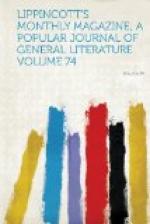The two days’ diligence journey from Grenoble to the departement des Hautes-Alpes was over one of those broad macadamized highways which make driving a luxury in many parts of Europe. If we were more huddled than in the less-antiquated Swiss diligences, we had the compensation of far more original fellow-travelers than one is apt to find among the tourists that monopolize those vehicles. There were generally two or three priests, half a dozen merry peasants, and a sprinkling of small officers and country-townspeople, who respectively lost no time in establishing a pleasant intimacy with their neighbors. The unflagging chatter, in which all joined vivaciously, and often all at once, was in striking contrast with the silent gloom which would have enshrouded a similar party of English or American travelers. It was impossible to resist the contagion of cheerfulness or to refuse to mingle more or less in the talk.
On the second evening, having trusted to the map and the very meagre information supplied by Murray, we found ourselves deposited at an isolated wayside cabaret. It presently transpired that St. Bonnet, where we expected to pass the Sunday, was some half mile or more off the high-road on which this was the nearest station. While we waited in a long, low, dimly-lighted room for the guide we had bespoken, two gendarmes and a peasant sat listening to, or rather looking at, a vivid account of some shooting adventure given in extraordinary pantomime by a deaf and dumb huntsman. In time a withered gnome trundling a wheelbarrow took possession of us and our light belongings, and led us forth into the night. We traversed the valley, mounted the hill on the other side, and at last entered the deeper night of a lampless village, and began to thread its steep, black streets. The only gleam of light was at what seemed to be the central fountain. Many women were gathered there, chatting as they filled their pails or stood with the replenished vessels poised on their heads. The inn was of a piece with all those at which we lodged in Dauphine, deficient in everything for which an inn exists. The feature of these inns which I remember, I think, with the least relish was the condition of the floors. It is literally true that they are never washed. A daily sprinkling is the only cleansing process they undergo: its effect is to soften the wood until it begins to absorb a large proportion of the rubbish which is often but never thoroughly swept up, and grows black and evil-odored. This result is most manifest, of course, and most offensive in the dining-rooms.
St. Bonnet offered even less than we anticipated of interest. On the Sunday morning we gladly drove away in such an equipage as the place afforded to the not very distant village of St. Laurent en Champsaur. Here we reached our first point in what was fifty years ago the parish of Felix Neff, and has been for centuries a refuge of Protestantism. It is a hamlet of stone cottages, lying on a kind of plateau and overlooking a wide and fertile valley. The surrounding hills, though mostly bare, were broken and beautified on that still autumn morning with dim clefts of shadow. The sun was not yet high, and broad masses of purple fell here and there across the plain and the brawling stream that divides it, still the Drac, which we had seen an almost stately river near Grenoble.




